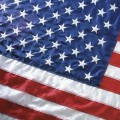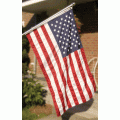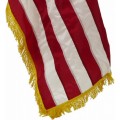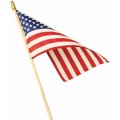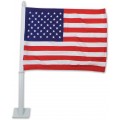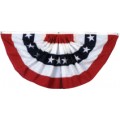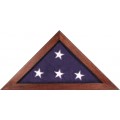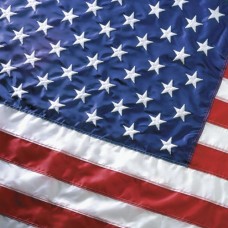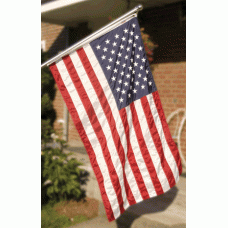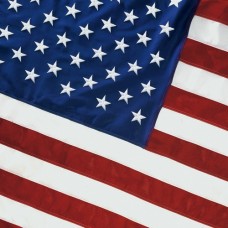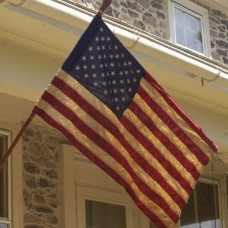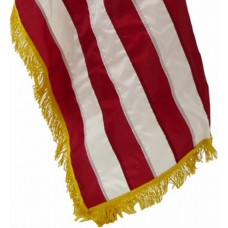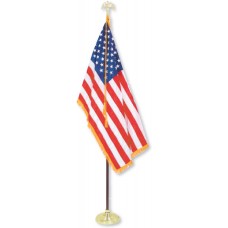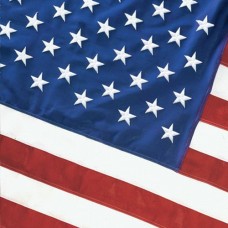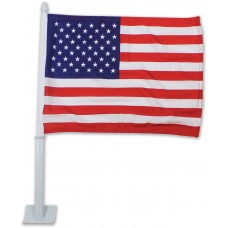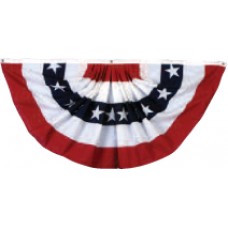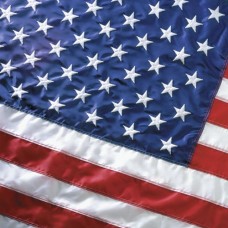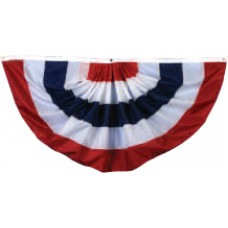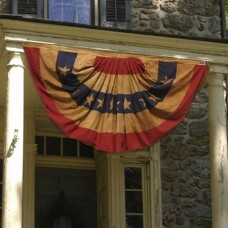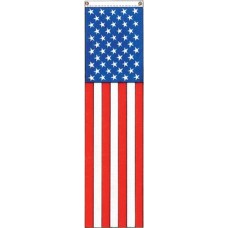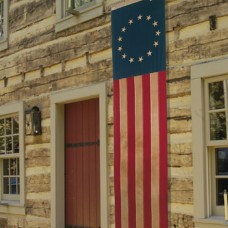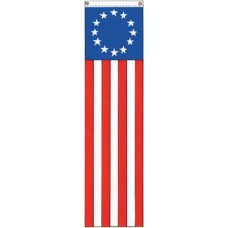American Flags - Shop for US Flags Made in USA
We sell premium grade American Flags which are manufactured under strict quality control guidelines to exceed US Government specifications. Our US flags feature industrial grade fabrics, sewn stripes, and embroidered stars and are constructed to last. We remove all of the unnecessary costs associated with packaging and marketing to sell you the top quality American Flags at the lowest prices possible. Our flags are delivered to you in simple poly bag packaging because we know that you are more concerned about purchasing the highest quality American Flag then paying more to cover unnecessary retail packaging costs.
In addition to indoor and outdoor American Flags, we also carry a full assortment of USA decor items including bunting, pleated fans, USA stick flags, pull down banners, car flags, and more, all of which are proudly made in the United States.
Comparison of American Flag Materials
We offer American Flags constructed from three different materials, each of which offers benefits and drawbacks.
- Nylon American Flags - Nylon is the most popular material used to construct American Flags in the United States. Nylon is a medium-weight flag material which offers the ideal balance between durability and fly-ability. Nylon Flags are light enough to fly in the slightest breeze, yet strong enough to endure the elements. This fabric offers a combination of high-strength and excellent color vibrancy and is a great choice for wet and rainy environments since it offers quick-drying ability.
- Polyester American Flags - Polyester is the most durable heavy-weight choice for American Flags. Polyester flags offer a rich look and feel and are the ideal choice for extreme weather conditions. Polyester flags are slightly heavier than nylon and therefore do not fly quite as well, however, they offer added durability. This is the choice for those individuals and organizations who want to purchase the absolute best quality flag.
- Cotton American Flags - Cotton offers the most authentic and traditional look and feel for American Flags. This material offers very vibrant and rich colors that are long-lasting and is ideal for special flag-flying ceremonies and holidays where authenticity is of utmost importance. Cotton flags are the least durable of the three choices, however, are also the most traditional looking.
Flag Construction Features
- We offer American Flags is 10 sizes ranging from 2' x 3' through 15' x 25'. Flags ranging in size from 2' x 3' through 6' x 10' are offered with a canvas heading and brass grommets, wheres flags measuring 8' x 12' and larger are produced with roped headings with galvanized metal thimbles.
- All of our American Flags are produced with durable stitching, brilliant white embroidered stars, and a reinforced fly end with 4 rows of stitching to prevent wear of the flag.
Displaying Your American Flag
- If you are looking for a complete American Flag Set, we offer our Build Your Own Outdoor American Flag Set and Build Your Own Indoor American Flag Set programs which include your choice of flag and all of the necessary hardware and accessories needed for a premium quality American Flag display.
- All of our flag sizes are offered with grommets and a canvas header. The grommets can be used to attach to he flag clips on your in-ground pole or the o-rings on your wall mount flagpole. Our 2-1/2' x 4' and 3' x 5' flags are also offered with the option of a sleeve with a sewn-in fabric tab to attach to the top clip on your wall-mount flagpole. The sleeved flag option is frequently used on front porch house flags and is always used for indoor flags.
- Our indoor flags are offered with the option of with gold fringe or without gold fringe. The gold fringe is the traditional way to display an indoor flag, however, many of our customers choose the flag without fringe for a more economical and simple approach.
What Size American Flag Should I Buy?
- In-Ground Flagpole Installations
For in-ground flagpoles, we recommend choosing a flag that is between 15%-25% the height of your flagpole. Bear in mind that the larger the flag, the larger the stress you are placing on the flagpole. If you are using a light-weight residential flagpole, we recommend choosing a smaller flag, whereas if you are using a very strong commercial flag, a larger flag will create a larger statement. The chart below is a guide for choosing the correct size flag for your in-ground flagpole:
Height of Flagpole Minimum Flag Size Maximum Flag Size 15ft. 2.5ft. x 4ft. 4ft. x 6ft. 20ft. 3ft. x 5ft. 5ft. x 8ft. 25ft. 3ft. x 5ft. 5ft. x 8ft. 30ft. 4ft. x 6ft. 6ft. x 10ft. 40ft. 5ft. x 8ft. 8ft. x 12ft. 50ft. 6ft. x 10ft. 10ft. x 15ft. 60ft. 8ft. x 12ft. 12ft. x 18ft. 70ft. 10ft. x 15ft. 15ft. x 25ft. 80ft. 10ft. x 19ft. 20ft. x 30ft. - Wall-Mount Flagpole Installations
If you are using a 6ft wall-mount flagpole, we recommend choosing a 3ft. x 5ft. flag, which will attach to the pole with the o-rings which connect to the grommets on the flag. Alternatively, if you are using a 5ft. pole, we recommend choosing a 2.5ft x 4ft. flag, which will attach to the pole with a sleeve which wraps around the pole and connects to the pole with a tab in the flag that attaches to a clip on the pole.
Half Staff American Flag Notifications
We boast over 30 years in the flag industry and can help you with all things flag-related including flag etiquette and half staff notifications. Our Half Mast Widget can be installed on your website to display the current status of the American Flag.
History of the American Flag
The American Flag is comprised of 13 alternating red and white horizontal stripes, with a blue canton containing 50 white, 5 pointed stars. Otherwise known as the Stars and Stripes, Star Spangled Banner, or Old Glory, the American flag combines both old and new. The 50 stars represent the current number of states in the Union, while the 13 bands stand for the 13 colonies which declared independence from the United Kingdom in 1776.
Since that time, the country has been involved in many internal and external conflicts, some of which have been reflected on the national flag at the time. Famous versions of the flag include the Grand Union Flag, the Betsy Ross Flag, and the Battle of Bennington Flag.
The Grand Union Flag of 1775 – 1777 featured the 13 stripes with the British Union Flag as the canton. The Betsy Ross version carries a distinctive canton with 13 stars arranged into a circle. The Battle of Bennington Flag has the distinctive number 76 as the main feature of its canton, referring to the year of the Declaration of Independence.
The inclusion of stars against a dark blue background was specified by the Flag Resolution of 1777, agreed by the 2nd Continental Congress. The design was to represent a new constellation in the sky, as the United States was a new country in the world.
The exact layout of those stars was never specified. Although there were initially 13 stars representing 13 states, the design was improvised as new states were added. This always takes place on 4 July of the year after the state's accession into the Union. On that date in 1890, 5 new stars were added, representing Idaho, Montana, North Dakota, South Dakota, and Washington. Idaho had joined the union on July 3rd.
Although the basic design of the American Flag has been settled since 1777, it was changed between 1795 and 1818. This period saw the addition of two extra stripes, taking the total to 15. This was to commemorate the accession of Vermont and Kentucky.
This design is the one referred to in the hymn The Star Spangled Banner. Also known as The Garrison Flag, this design flew over Baltimore Harbor during the British siege there in the American Revolutionary War. The 13 stripe design was re adopted in 1818, since then it has remained the same.
In recent times, there have been votes by residents of both Puerto Rico and the District of Columbia (DC) to gain statehood. Were either or both of these to be accepted by Congress, one or two extra stars would need to be accommodated. If so, this would be the latest development in a flag with a fascinating history.
Who Designed the First American Flag?
According to legend, Betsy Ross is the creator of the first rendition of the American Flag. The legend states that Betsy Ross created the flag based on a hand-drawn sketch by George Washington. The historical record does not corroborate this story since there is no mention of the exchange in George Washington's diaries, nor is there a mention of it in the records of Congress. Betsy Ross was in fact an upholsterer and a flag-maker, however, there is not strong evidence that she did indeed create the first American Flag nor is there evidence that she created the design of thirteen five-pointed stars in a circular pattern that is generally attributed to her.
On June 14, 1777, the Second Continental Congress passed a Flag Resolution, which specified the following: "That the flag of the thirteen United States be thirteen stripes, alternate red and white; that the union be thirteen stars, white in a blue field, representing a new constellation." Today, each year on June 14th is celebrated as "Flag Day" in the United States to commemorate this occasion. The resolution by the Congress did not specifically state the arrangement of the stars, the proportional shape of the flag, the arrangement of the stripes (7 red & 6 white or 6 red & 7 white), the number of points on the stars, or any number of other specifics. As a result, there were likely many "First American Flags" created which fulfill the requirements outlines by the congress. In fact, between 1779 and 1796, there are at least 17 known variants of the US flag that were used. In 1777, there was no notion of a National Flag, so the resolution was likely meant to specify a naval ensign to be flown by the United States Navy.
One notable figure who designed many variants of early American Flags was, Francis Hopkinson. Hopkinson was also involved with the design of early coins and money of the United States. According to most historians, Betsy Ross's role in the creation of an early American Flag was likely more as a tradeswoman who produced the flag as an entrepreneur, rather than a designer. Hopkins is the only person to have claimed that he was the original designer of the American Flag during his lifetime, and, in fact he issued several bills to the Congress as payment for his services in designing the flag, which appear to have never been paid. Hopkins actually designed two flags: One flag to be used by the US Navy, and one flag to be used by the country as a whole. Hopkinson's designs featured six-point stars as opposed to the five-point stars we are familiar with today. The US Navy version of the flag, featured seven red stripes and six white stripes, such that the top and bottom stripe were red, making them contrast against the blue sky and blue ocean. The standard US Flag that he designed featured seven white stripes and six red stripes instead.
Need Assistance?
Flagdom has been a leader in the flag and flagpole industry for over 30 years. If you have any questions about selecting the best US flag, please reach out to us by phone, chat, or email. We look forward to putting our experience to work for you.
How to Dispose of an American Flag
When your American Flag has reached the end of its life, the preferred disposal method, according the United States Flag Code is to Burn the flag. If you are not comfortable burning the flag yourself, we suggest donating your flag to a local organization such as the Boy Scouts, The American Legion, or the Girl Scouts, who each have programs whereby they conduct a ceremony and retire the American Flag in accordance with the United States Flag Code.

